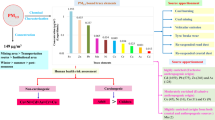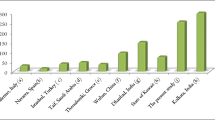Abstract
Risk analysis is extremely important in toxicology and public health studies. Health risk associated with the exposure to potentially toxic elements (PTEs), including As, Ba, Cr, Cu, Pb, Mn, Ni, Sb, Sr, V, and Zn, of ambient fine particles less than 2.5 μm in diameter (PM2.5) at day and night time during firework events was assessed. An hourly PM2.5 elemental measurements were conducted from October 16 to November 16, 2014 at central London, using Xact™ 625 automated multi-metals monitor. Results showed higher concentration of metals attributable to firework combustion emissions (including: Ba, Cu, Sb, and Sr) at night time compared to day time. 95th percentile of total PM2.5-PTEs showed combined (inhalation and ingestion) non-cancer risk for children (hazardous index, HI: 3.0) and adults (HI: 1.58) at night time, implicating the fireworks events; PM2.5-PTEs was found to be potentially harmful to only children (HI: 2.2) at day time. Cancer risk of the inhalation and the ingestion of PM2.5-As and PM2.5-Cr was lower than the threshold level of concern for both children and adults.



Similar content being viewed by others
References
AQS-EEC (2015) Air quality standards - environment - European commission. http://ec.europa.eu/environment/air/quality/standards.htm. Accessed 7 Nov 2015
ATSDR (2011) Agency for toxic substances and disease registry, draft toxicological profiles, http://www.atsdr.cdc.gov/toxprofiles/index.asp
Baek BH, Aneja VP (2005) Observation based analysis for the determination of equilibrium time constant between ammonia, acid gases, and fine particles. Int J Environ Pollut 23:239–247
Bowman DM, Johnston FH (2005) Wildfire smoke, fire management, and human health. EcoHealth 2:76–80
Brown SS, Ryerson TB, Wollny AG et al (2006) Variability in nocturnal nitrogen oxide processing and its role in regional air quality. Science 311:67–70
Brunekreef B, Dockery DW, Krzyzanowski M (1995) Epidemiologic studies on short-term effects of low levels of major ambient air pollution components. Environ Health Perspect 103:3
Charron A, Harrison RM (2003) Primary particle formation from vehicle emissions during exhaust dilution in the roadside atmosphere. Atmos Environ 37:4109–4119
DEP (2008) Characterization of risks due to inhalation of particulates by construction workers. Department of environmental protection
Fang W, Yang Y, Xu Z (2013) PM10 and PM2. 5 and health risk assessment for heavy metals in a typical factory for cathode ray tube television recycling. Environ Sci Technol 47:12469–12476
Godri KJ, Green DC, Fuller GW et al (2010) Particulate oxidative burden associated with firework activity. Environ Sci Technol 44:8295–8301
Hamad SH, Schauer JJ, Shafer MM et al (2014) Risk assessment of total and bioavailable potentially toxic elements (PTEs) in urban soils of Baghdad–Iraq. Sci Total Environ 494:39–48
Haney JT Jr, Erraguntla N, Sielken RL Jr, Valdez-Flores C (2012) Development of a cancer-based chronic inhalation reference value for hexavalent chromium based on a nonlinear-threshold carcinogenic assessment. Regul Toxicol Pharmacol 64:466–480
Hayes AW, Kruger CL (2014) Hayes’ principles and methods of toxicology. CRC Press, Boca Raton
Hirai K, Yamazaki Y, Okada K et al (2000) Acute eosinophilic pneumonia associated with smoke from fireworks. Intern Med 39:401–403
Jomova K, Jenisova Z, Feszterova M et al (2011) Arsenic: toxicity, oxidative stress and human disease. J Appl Toxicol 31:95–107
Kosanke K, Kosanke B, Dujay R (2000) Pyrotechnic particle morphologies-metal fuels. J Pyrotech 2000:46–52
Laden F, Schwartz J, Speizer FE, Dockery DW (2006) Reduction in fine particulate air pollution and mortality extended follow-up of the Harvard six cities study. Am J Respir Crit Care Med 173:667–672
Lave LB, Seskin EP (2013) Air pollution and human health. Routledge, New York
Li W, Shi Z, Yan C et al (2013) Individual metal-bearing particles in a regional haze caused by firecracker and firework emissions. Sci Total Environ 443:464–469
Licudine JA, Yee H, Chang WL, Whelen AC (2012) Hazardous metals in ambient air due to New Year fireworks during 2004–2011 celebrations in Pearl City, Hawaii. Public Health Rep 127:440
Moya J, Phillips L, Laurie S (2011) Exposure factors handbook. Washington, DC: Environmental protection agency, office of research and development, US environmental protection agency
Peters A, Dockery DW, Heinrich J, Wichmann HE (1997) Short-term effects of particulate air pollution on respiratory morbidity in asthmatic children. Eur Respir J 10:872–879
Putaud J-P, Raes F, Van Dingenen R et al (2004) A European aerosol phenomenology—2: chemical characteristics of particulate matter at kerbside, urban, rural and background sites in Europe. Atmos Environ 38:2579–2595
Ravindra K, Mor S, Kaushik CP (2003) Short-term variation in air quality associated with firework events: a case study. J Environ Monit 5:260–264
Reiss R, Anderson EL, Cross CE et al (2007) Evidence of health impacts of sulfate-and nitrate-containing particles in ambient air. Inhal Toxicol 19:419–449
Saha U, Talukdar S, Jana S, Maitra A (2014) Effects of air pollution on meteorological parameters during Deepawali festival over an Indian urban metropolis. Atmos Environ 98:530–539
Schaap M, Müller K, Ten Brink HM (2002) Constructing the European aerosol nitrate concentration field from quality analysed data. Atmos Environ 36:1323–1335
Schauer JJ (2003) Evaluation of elemental carbon as a marker for diesel particulate matter. J Expo Sci Environ Epidemiol 13:443–453
Schwartz J, Norris G, Larson T et al (1999) Episodes of high coarse particle concentrations are not associated with increased mortality. Environ Health Perspect 107:339
Shrey K, Suchit A, Deepika D et al (2011) Air pollutants: the key stages in the pathway towards the development of cardiovascular disorders. Environ Toxicol Pharmacol 31:1–9
US EPA (1989) Risk assessment guidance for superfund, human health evaluation manual. Part A (Interim Final), Off Emerg Remedial Response US Environ Prot AgencyWashington DC. doi: EPA/540/1-89/002
US EPA (2012) Exposure assessment. US environment protection agency
US EPA (2012) Cancer risk coefficients for environmental exposure to radionuclides federal guidance report No. 13. BiblioGov
Walker S (2008) US EPA superfund radiation policy and guidance
Wang Y, Zhuang G, Xu C, An Z (2007) The air pollution caused by the burning of fireworks during the lantern festival in Beijing. Atmos Environ 41:417–431
Zheng N, Liu J, Wang Q, Liang Z (2010) Health risk assessment of heavy metal exposure to street dust in the zinc smelting district, Northeast of China. Sci Total Environ 408:726–733
Acknowledgments
Authors would like to thank Anja Tremper and Max Priestman from the Environmental Research group/ School of Biomedical Sciences at King’s College London, UK, for their help in chemical measurements. Authors are grateful to Heather Walton at the School of Biomedical Sciences, King’s College London for her insightful comments on the manuscript. This work was funded by UK Natural Environment Research Council grants-Clearflo (NE/H003231/1) and Traffic (NE/I008039/1).
Author information
Authors and Affiliations
Corresponding author
Electronic supplementary material
Below is the link to the electronic supplementary material.
ESM 1
(PDF 341 kb)
Rights and permissions
About this article
Cite this article
Hamad, S., Green, D. & Heo, J. Evaluation of health risk associated with fireworks activity at Central London. Air Qual Atmos Health 9, 735–741 (2016). https://doi.org/10.1007/s11869-015-0384-x
Received:
Accepted:
Published:
Issue Date:
DOI: https://doi.org/10.1007/s11869-015-0384-x




